Step into a world where fantasy meets modern comfort with castlecore, the hottest interior design trend of 2025. Inspired by medieval grandeur and beloved stories like Game of Thrones and Lord of the Rings, this style brings royal elegance to everyday living. Whether you’re a renter or a homeowner, castlecore offers endless ways to create a magical retreat.
This trend isn’t just about heavy stone walls or towering turrets. It blends antique charm with cozy, livable spaces. Think rich tapestries, vintage furniture, and soft candlelight—all while keeping modern convenience. Designer Stephanie Wiott praises its versatility, proving castlecore works in apartments, suburban homes, and even minimalist spaces.
Ready to turn your home into a storybook escape? Below, we’ll explore 10 achievable ideas—from DIY stone wallpaper to opulent textiles—that fit any budget or style. Let’s bring your fairytale vision to life!
Key Takeaways
- Castlecore merges medieval-inspired design with modern home comforts.
- Pop culture influences like fantasy books and shows drive its popularity.
- The trend adapts to any space, whether rented or owned.
- Key elements include antique furniture, atmospheric lighting, and rich fabrics.
- Affordable DIY projects make it accessible for all budgets.
What Is Castlecore? Defining the Aesthetic
Dive into a design trend where medieval grandeur meets modern living. Castlecore isn’t just about stone walls or chandeliers—it’s a celebration of history, fantasy, and comfort. This aesthetic draws from 12th–19th century European castles, blending defensive architecture with royal opulence.
The Origins of Castlecore in Pop Culture
From *Game of Thrones* to *The Witcher*, fantasy worlds have fueled this trend. Pinterest coined the term in 2023, but its roots trace back to Tudor and Regency-era designs. Chappell Roan’s 2024 VMAs look, featuring velvet and wrought iron, showcased its fashion counterpart.
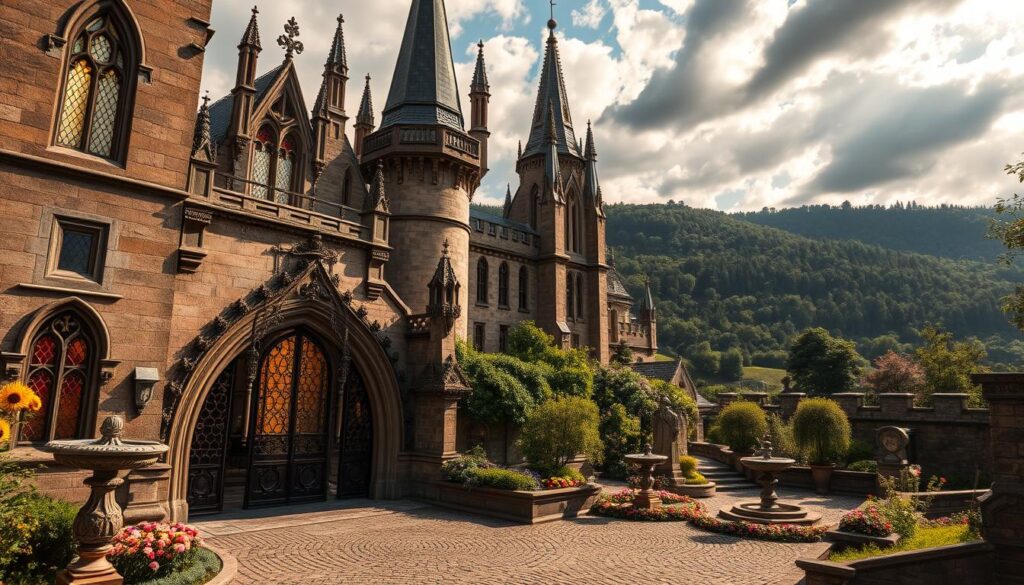
Key Elements: Opulence Meets History
Castlecore balances rugged materials with luxurious details. Think raw stone walls paired with velvet drapes or antique armoires beside sleek modern sofas. Designer Stephanie Wiott explains:
“It blends opulent designs with everyday comfort, making history feel livable.”
Signature features include:
- Tapestries with heraldic motifs
- Wrought iron lighting fixtures
- Raw stone or brick accents
- Velvet textiles in jewel tones
- Antique case goods like trunks and credenzas
| Style | Focus | Materials |
|---|---|---|
| Castlecore | Medieval grandeur + modern comfort | Stone, velvet, wrought iron |
| Cottagecore | Rustic pastoral charm | Wood, linen, floral prints |
Unlike Gothic Revival’s sharp arches or Dark Academia’s moody libraries, castlecore feels warm and inviting. It’s a style that turns homes into storybook escapes without sacrificing practicality.
Embrace Moody Jewel Tones for a Regal Feel
Jewel tones bring depth and drama to any room, perfect for a regal touch. Historically, castles used rich hues like oxblood and emerald to combat dim lighting. These colors absorbed scarce natural light, creating warmth in stone halls.
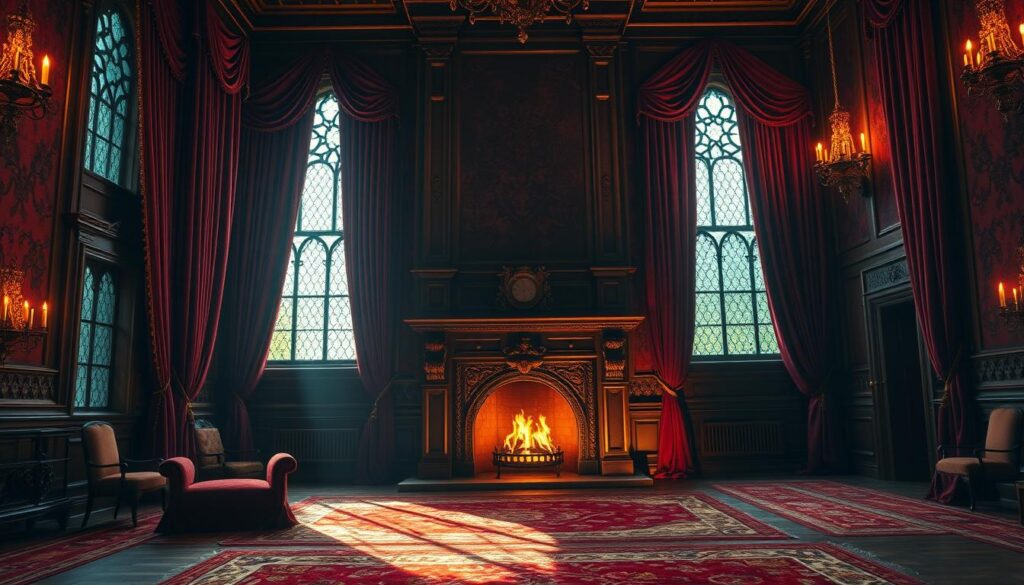
Best Paint Colors for Statement Walls
Modern brands offer shades inspired by natural dyes. Farrow & Ball’s Scotch Blue mimics aged tapestries, while Benjamin Moore’s Hunter Green evokes forested estates. For bold contrast, try Sherwin-Williams’ Urbane Bronze.
Top 6 signature shades:
- Oxblood: Deep red with rustic undertones
- Emerald: Vibrant yet grounding
- Sapphire: Cool and majestic
- Aubergine: Moody purple for libraries
- Charcoal: Neutral with historic grit
- Gold Ochre: Warm metallic accents
| Brand | Color | Best For |
|---|---|---|
| Benjamin Moore | Newburg Green | Studies |
| Backdrop | Self-Portrait | Matte accent walls |
| Farrow & Ball | Scotch Blue | Dining rooms |
Balancing Dark Hues in Modern Spaces
Designer Stephanie Wiott suggests pairing jewel tones with muted earth tones. Try a beige sofa against an emerald wall for contrast. Renters can use peel-and-stick wallpaper for temporary drama.
Lighting tips: Place mirrors opposite windows to reflect light. Layer brass sconces or candlesticks for warmth. Avoid overhead lights—they flatten rich colors.
Swap Overhead Lighting for Candelabras and Sconces
Castles once relied on candlelight to illuminate their grandeur—now you can too with strategic sconces and candelabras. Medieval homes used 3–5 light sources per room to combat dim interiors. Today, this approach creates ambiance while honoring history.
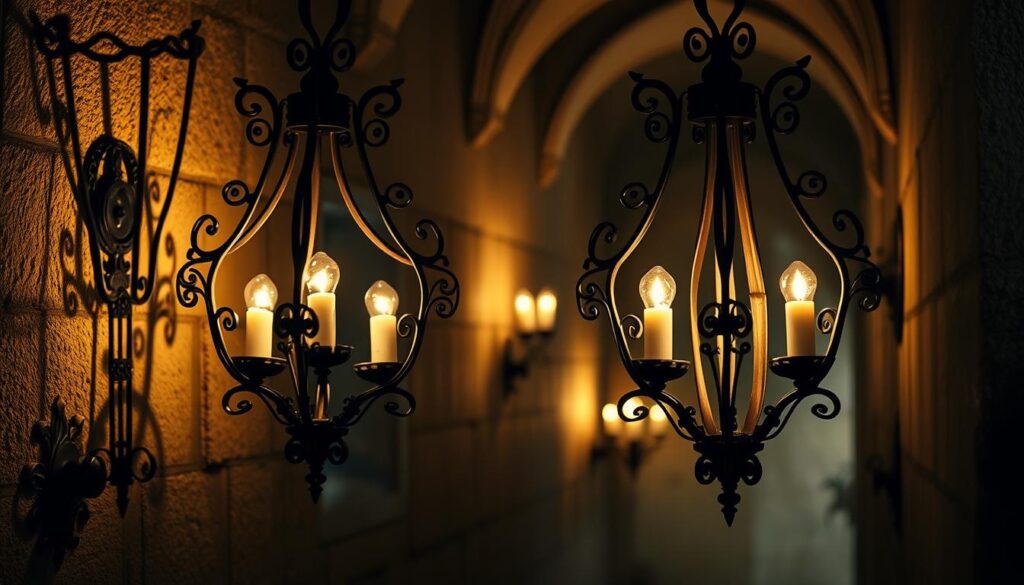
Choosing the Right Candle Holders
Wrought iron and brass finishes dominate castlecore lighting. The CB2 Vela Sconce (26% off) offers blackened iron for rustic charm, while Arhaus’s Artemis Wall Holder (20% off) features antique bronze. Consider these finishes:
- Aged brass: Warms modern spaces
- Blackened iron: Adds rugged texture
- Antique bronze: Blends with vintage decor
Placement for Maximum Impact
Install wall sconces at 66″ height—eye level for most adults. Create zones:
- Cluster 2–3 in entryways
- Pair beside beds for reading light
- Group taper candle trios on dining tables
Fredericks & Mae’s double-armed holders make bold statements. For safety, keep flames 12″ from fabrics.
Pro tip: Mix LED taper candles with real ones for worry-free lighting. Renters can craft DIY wrought iron sconces using vintage brackets and battery-operated flameless candles.
Hang Tapestries to Add Drama and History
Medieval tapestries weren’t just decor—they were insulation, art, and status symbols rolled into one. These woven masterpieces kept castles warm while telling stories of battles and royalty. Today, they’re a must-have for the castlecore look, instantly transforming plain walls into historic showcases.
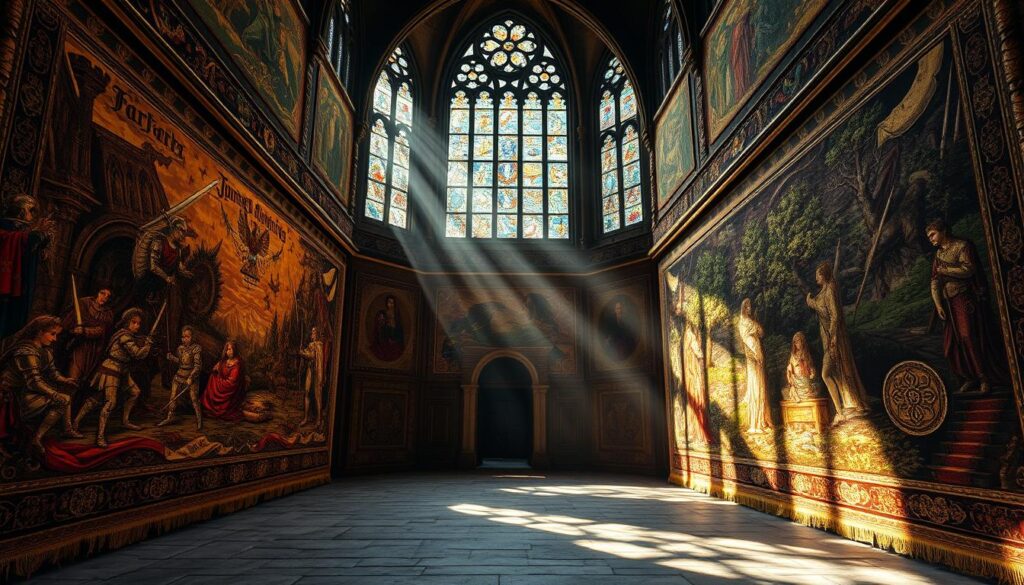
Modern Takes on Medieval Designs
Forget outdated floral motifs. Contemporary tapestries feature abstract landscapes, geometric patterns, and nature themes. Pottery Barn’s Greenwood Tapestry ($349) offers a muted forest scene, while 1stDibs sells 19th-century Aubusson pieces ($9,500+) for serious collectors.
Top trends:
- Jewel-toned abstract designs that add depth to small spaces
- Minimalist line art for modern-meets-medieval vibes
- Nature-inspired motifs like stag silhouettes or heraldic symbols
Unexpected Places to Display Tapestries
Designer Nate Berkus proves they’re not just for walls. Try these creative placements:
- Bed canopies: Drape a lightweight tapestry above your bed for a royal touch
- Closet doors: Hide plain sliders with a floor-length textile
- Room dividers: Layer two tapestries back-to-back for a movable partition
Pro tip: Hang a tapestry behind floating shelves to create a textured backdrop. For large walls, aim for 6’ widths—ideal above sofas or dining tables.
“A well-placed tapestry anchors a room’s story. It’s history you can live with.”
DIY option: Iron-on medieval motifs onto fabric panels for budget-friendly art. Martyn Lawrence Bullard’s Veranda-approved wall of layered tapestries proves mixing eras adds intrigue.
Care tips: Vacuum monthly to prevent dust buildup. Rotate pieces to avoid sun damage. For delicate antiques, consult a textile conservator.
Incorporate Stone and Raw Materials Authentically
Raw materials like stone and wood bring castlecore authenticity to any space. These elements anchor the design in history while adding tactile warmth. From faux stone wallpaper to wire-brushed oak floors, options abound for every budget.

Budget-Friendly Stone Accents
You don’t need a quarry to achieve the look. Try these affordable ideas:
- Limestone contact paper: Apply to kitchen backsplashes or fireplace surrounds for instant texture.
- Concrete coasters: Mimic cobblestone at a fraction of the cost (Williams Sonoma’s marble cutting boards start at $49).
- Stone-look laminate flooring: Renters can achieve flagstone visuals without permanent changes.
Unpainted Wood for Rustic Charm
Natural wood grains add organic contrast to stone. Designer Stephanie Wiott recommends:
- Wire-brushed oak: Highlights the wood’s natural grooves for aged character.
- Cerused finishes: Whitewash techniques let grain patterns peek through.
- Leather-strapped hardware: Swap modern pulls for straps on cabinets or trunks.
| Material | Cost Range | Best For |
|---|---|---|
| Slate tile | $5–$15/sq ft | Entryways, bathrooms |
| Wide-plank walnut | $8–$20/sq ft | Living rooms, bedrooms |
| Plaster walls | $2–$5/sq ft | DIY stone illusions |
Pro tip: Pair stone with iron accents—like wrought iron lighting—to balance rugged and refined. For maintenance, seal natural materials annually to prevent stains.
“Plaster walls layered with ochre pigment mimic centuries-old stonework. It’s history made modern.”
Choose Luxe Textiles Like Velvet and Heavy Drapery
Nothing says royal comfort like sumptuous velvet and cascading drapery in a modern home. Medieval nobles used these textiles to showcase wealth—today, they’re central to the castlecore trend. Wayfair reports a 41% surge in velvet sales for 2025, proving its timeless appeal.
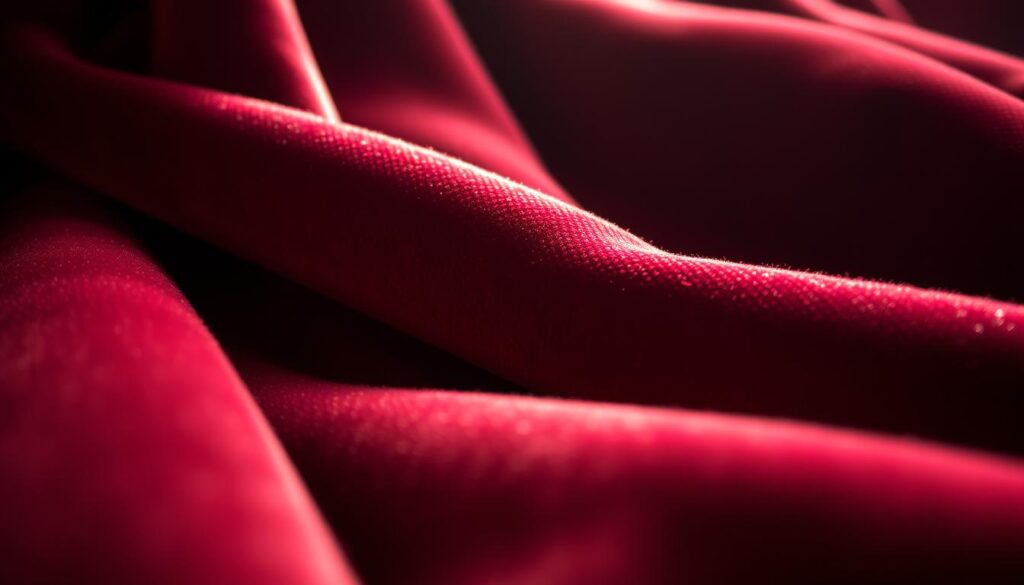
Velvet That Works for Real Life
Not all velvets are created equal. Designer Heather Chadduck Hillegas favors these practical options:
- Crushed velvet: Hides pet hair while adding depth
- Performance velvet: Stain-resistant for busy households
- Chenille: Softer texture for throw pillows
The Arhaus Granby Chair (30% off) showcases panne velvet’s luminous finish. For smaller spaces, Williams Sonoma’s Soho Bench ($1,695) adds emerald luxury without overwhelming.
The Art of Layering Fabrics
Castles layered textiles for warmth—copy this technique with:
- A jute rug as your base layer
- A Persian-style rug atop for pattern
- Sheepskin throws draped over chairs
“Drapery should pool slightly on the floor—aim for 130″ lengths with blackout lining for true castle drama.”
Pro tip: Make DIY tassel tie-backs from upholstery cord. They’ll elevate basic curtains instantly. For four-poster beds, follow Hillegas’ lead with heavyweight velvet canopies trimmed in gold bullion.
Opt for Ornate Case Pieces Over Modern Storage
Before walk-in closets existed, castles relied on grand armoires and trunks for storage—now these pieces are making a stylish comeback. Pre-20th century homes used case goods as both functional storage and status symbols. Today, they anchor the castlecore look while hiding TVs, serving as bar cabinets, or organizing linens.
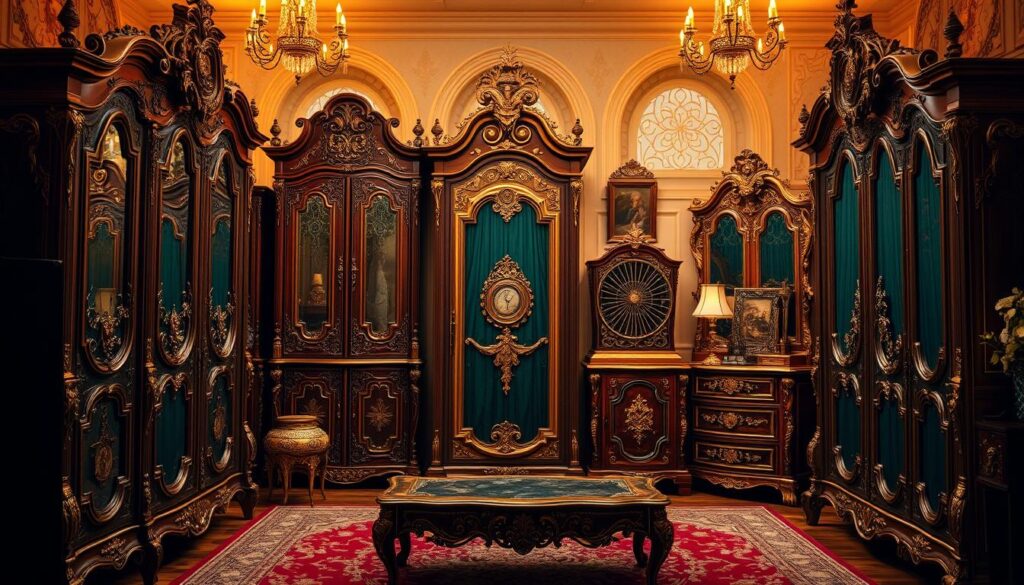
Armoires and Trunks as Functional Art
Invest in statement-makers like 1stDibs’ Swedish Armoire ($5,850) with hand-carved motifs. For modern spaces, Article’s Mysen Cabinet blends clean lines with medieval-inspired iron hardware. Designer Juan Pablo Molyneux proves their versatility:
“A carved credenza becomes a room’s anchor piece—it tells a story while holding your grandmother’s china.”
Creative uses for antique pieces:
- Convert marketplace dressers into bathroom vanities
- Use narrow hall trunks with lift tops for seasonal decor
- Line drawers with heraldic-print paper for hidden drama
Blending Centuries in Your Design
Pair Georgian chests with acrylic chairs for time-defying contrast. Restoration expert Lola Nova advises:
- Replace missing hardware with reproduction pulls
- Use beeswax polish to nourish old wood
- Display candelabras atop staggered-height pieces
For renters, temporary wallpaper inside open shelving mimics aged wood. The key? Let each piece’s history shine through modern arrangements.
Create a Dining Space Fit for Royal Gatherings
Dining rooms became throne rooms in castle design, where hosts showcased wealth through table settings. Modern homes can capture this drama with intentional furniture choices and atmospheric details. Whether hosting feasts or family dinners, these ideas blend history with functionality.

Table Shapes That Command Attention
Medieval halls favored two styles: imposing long tables for hierarchical seating and round “King Arthur” tables promoting equality. For modern spaces:
- Long tables: Choose 96″+ lengths for authentic scale. Restoration Hardware’s Belgian Farmhouse Table (from $3,295) offers hand-hewn charm.
- Round tables: Require 60″ diameter for comfortable seating. CB2’s Lochan Candle Holder ($199) makes an ideal centerpiece.
Pair with Savonarola chairs for folded leather elegance or X-back designs for rustic contrast. Designer Mickey Hurley notes:
“A dining table should feel like an event—its scale sets the tone before the first course arrives.”
Setting the Scene With Vintage Flair
Castle hosts used tableware as status symbols. Recreate the look with:
- Charger plates: Layer beneath modern dishware. Etsy’s heraldic designs start at $28.
- Goblets: Mix thrifted crystal with IKEA’s 365+ glasses ($3.99 each).
- Napkin rings: Hunt for lion-head or fleur-de-lis designs at flea markets.
For lighting, hang a three-tier chandelier 30″ above the dining table. The boho-inspired iron designs add medieval weight without stuffiness.
Pro tip: Disguise charging stations inside hollowed candle boxes. Polish thrifted silver plate with baking soda paste for instant vintage appeal.
DIY Castlecore: Easy Projects for Renters or Beginners
Renters and beginners can achieve a royal aesthetic without permanent changes using these clever hacks. From peel-and-stick stone walls to no-sew tapestries, these projects blend history with modern convenience. Best of all, they require minimal time and tools.
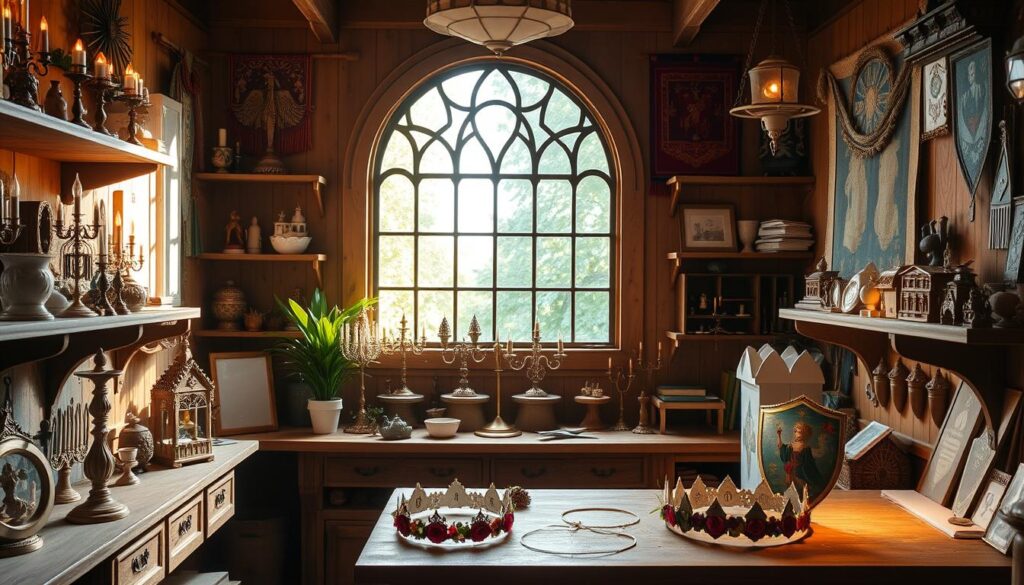
Peel-and-Stick Stone Wallpaper Tutorials
Tempaper’s Faux Stone Wallpaper ($35/roll) creates instant drama. Apply it to accent walls, fireplace surrounds, or even closet doors. Designer Courtney Cachet recommends:
“Measure twice, cut once—and use a squeegee to smooth bubbles for a flawless finish.”
Renter-friendly tip: Pair with removable adhesive hooks for hanging wrought iron sconces. For texture, layer with DIY stone-look coasters using concrete molds.
Hand-Sewn Tapestry and Pillow Designs
Spoonflower’s custom fabric ($22/yd) lets you print medieval motifs without sewing. Try these ideas:
- No-sew tapestry: Wrap fabric around a dowel rod with fabric glue. Add tassels for regal flair.
- Stenciled pillows: Use heraldic stencils and fabric paint on linen covers.
- Iron-on decals: Transform plain curtains with leaded window designs.
For distressed wood mirrors, sand edges and stain with walnut ink. Spray-paint thrifted frames with antique bronze for instant patina.
These DIY projects prove castlecore isn’t just for historic homes. With creativity, even small elements can transport you to a fairytale realm.
Conclusion: Living Your Modern Fairytale
Transform your home into a sanctuary where history meets comfort. With 89% of adopters reporting higher satisfaction (Living Bright Interiors), castlecore proves more than a fleeting trend—it’s a celebration of craftsmanship.
Start small: a velvet chair or iron sconce can set the tone. Designer Stephanie Wiott notes, “It honors the past while fitting modern lives.” Visit antique malls for unique finds or try a teacup garden fortress DIY.
Blend raw materials with soft textiles for balance. Share your creations online to inspire others. This world of medieval charm awaits—one tapestry or candelabra at a time.
Continue reading: Explore our curated list of featured products to begin your journey.

